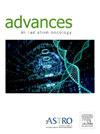Performance Comparison of 10 State-of-the-Art Machine Learning Algorithms for Outcome Prediction Modeling of Radiation-Induced Toxicity
IF 2.7
Q3 ONCOLOGY
引用次数: 0
Abstract
Purpose
To evaluate the efficacy of prominent machine learning algorithms in predicting normal tissue complication probability using clinical data obtained from 2 distinct disease sites and to create a software tool that facilitates the automatic determination of the optimal algorithm to model any given labeled data set.
Methods and Materials
We obtained 3 sets of radiation toxicity data (478 patients) from our clinic: gastrointestinal toxicity, radiation pneumonitis, and radiation esophagitis. These data comprised clinicopathological and dosimetric information for patients diagnosed with non-small cell lung cancer and anal squamous cell carcinoma. Each data set was modeled using 11 commonly employed machine learning algorithms (elastic net, least absolute shrinkage and selection operator [LASSO], random forest, random forest regression, support vector machine, extreme gradient boosting, light gradient boosting machine, k-nearest neighbors, neural network, Bayesian-LASSO, and Bayesian neural network) by randomly dividing the data set into a training and test set. The training set was used to create and tune the model, and the test set served to assess it by calculating performance metrics. This process was repeated 100 times by each algorithm for each data set. Figures were generated to visually compare the performance of the algorithms. A graphical user interface was developed to automate this whole process.
Results
LASSO achieved the highest area under the precision-recall curve (0.807 ± 0.067) for radiation esophagitis, random forest for gastrointestinal toxicity (0.726 ± 0.096), and the neural network for radiation pneumonitis (0.878 ± 0.060). The area under the curve was 0.754 ± 0.069, 0.889 ± 0.043, and 0.905 ± 0.045, respectively. The graphical user interface was used to compare all algorithms for each data set automatically. When averaging the area under the precision-recall curve across all toxicities, Bayesian-LASSO was the best model.
Conclusions
Our results show that there is no best algorithm for all data sets. Therefore, it is important to compare multiple algorithms when training an outcome prediction model on a new data set. The graphical user interface created for this study automatically compares the performance of these 11 algorithms for any data set.
10种最先进的机器学习算法在辐射毒性结果预测建模中的性能比较。
目的:利用从两个不同疾病部位获得的临床数据,评估著名机器学习算法在预测正常组织并发症概率方面的功效,并创建一个软件工具,促进自动确定最佳算法来模拟任何给定的标记数据集。方法和材料:我们从临床获得3组(478例)放射毒性资料:胃肠道毒性、放射性肺炎和放射性食管炎。这些数据包括诊断为非小细胞肺癌和肛门鳞状细胞癌的患者的临床病理和剂量学信息。每个数据集使用11种常用的机器学习算法(弹性网络、最小绝对收缩和选择算子[LASSO]、随机森林、随机森林回归、支持向量机、极端梯度增强、轻梯度增强机、k近邻、神经网络、贝叶斯-LASSO和贝叶斯神经网络)进行建模,随机将数据集划分为训练集和测试集。训练集用于创建和调整模型,测试集用于通过计算性能指标来评估模型。每个算法对每个数据集重复该过程100次。生成图形以直观地比较算法的性能。开发了一个图形用户界面,使整个过程自动化。结果:LASSO对放射性食道炎的精确召回曲线下面积最高(0.807±0.067),对胃肠道毒性的随机森林面积最高(0.726±0.096),对放射性肺炎的神经网络面积最高(0.878±0.060)。曲线下面积分别为0.754±0.069、0.889±0.043、0.905±0.045。图形用户界面用于自动比较每个数据集的所有算法。当对所有毒性的精确召回曲线下的面积进行平均时,贝叶斯-拉索模型是最佳模型。结论:我们的研究结果表明,对于所有数据集,没有最好的算法。因此,在新数据集上训练结果预测模型时,比较多种算法是很重要的。为本研究创建的图形用户界面自动比较了这11种算法对任何数据集的性能。
本文章由计算机程序翻译,如有差异,请以英文原文为准。
求助全文
约1分钟内获得全文
求助全文
来源期刊

Advances in Radiation Oncology
Medicine-Radiology, Nuclear Medicine and Imaging
CiteScore
4.60
自引率
4.30%
发文量
208
审稿时长
98 days
期刊介绍:
The purpose of Advances is to provide information for clinicians who use radiation therapy by publishing: Clinical trial reports and reanalyses. Basic science original reports. Manuscripts examining health services research, comparative and cost effectiveness research, and systematic reviews. Case reports documenting unusual problems and solutions. High quality multi and single institutional series, as well as other novel retrospective hypothesis generating series. Timely critical reviews on important topics in radiation oncology, such as side effects. Articles reporting the natural history of disease and patterns of failure, particularly as they relate to treatment volume delineation. Articles on safety and quality in radiation therapy. Essays on clinical experience. Articles on practice transformation in radiation oncology, in particular: Aspects of health policy that may impact the future practice of radiation oncology. How information technology, such as data analytics and systems innovations, will change radiation oncology practice. Articles on imaging as they relate to radiation therapy treatment.
 求助内容:
求助内容: 应助结果提醒方式:
应助结果提醒方式:


